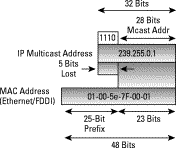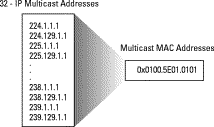


Address Translation
A multicast address enables the delivery of datagrams to a set of hosts that have been configured as members of a multicast group in various scattered subnetworks. A Class D address is a multicast address and identifies the group of machines or interfaces that represent a multicast group. For example, a Class D address could identify all the interfaces attached to IP network routers. All logical holders of a particular Class D address receive packets sent to that address.
The destination address field of the IP header in a multicast IP packet contains a Class D group address instead of a Class A, B, or C IP address. A Class D address is an IP address and has the format 224.0.0.0 - 239.255.255.255, i.e. those with 1110 as their high-order four bits.
Local Scoped Addresses
These are addresses in the range 224.0.0.0 through 224.0.0.255. These are reserved by the IANA for network protocol usage and as such include addresses such as,
| 224.0.0.1 | All Hosts |
| 224.0.0.2 | All Multicast Routers |
| 224.0.0.3 | All DVMRP Routers |
| 244.0.0.5 | All OSPF Routers |
| 244.0.0.6 | All OSPF DR |
Multicasts in this range are never forwarded off the local network regardless of the TTL. These multicasts are usually sent 'link local' with TTL=1.
Globally Scoped Addressing
The range of addressses from 224.0.1.0 to 238.255.255.255 are called Globally Scoped Addresses. They can be used to multicast data between organisations and across the internet. Amongst these addresses is the Network Time Protocol (NTP) located at 244.0.1.1. They are allocated dynamically throughout the internet.
Limited Scope Addresses
The addresses from 239.0.0.0 through 239.255.255.255 are called Limited Scope Addresses or Administratively Scoped Addresses. These are defined in RFC 2365 to be constrained to a local group or organisation. Routers are typically configured with filters to prevent multicast traffic in this address range from flowing outside of an Autonomous System (AS) or any user defined domain. Within an Autonomous System or domain the Limited Scope address range can be further subdivided so that local multicast boundaries can be defined. This will also allow for address reuse between these smaller domains.
Glop Addressing
RFC 2770 proposes that the 233.0.0.0/8 address range be reserved for statically defined addresses that already have an AS number reserved. The AS number of the domain is embedded into the second and third octets of the 233.0.0.0/8 range. eg. the AS 62010 is written in hex as F23A. Separating out the two octets, F2 and 3A we get 242 and 58 in decimal, giving a subset of 233.242.58.0 that would be globabbly reserved for this AS.
In Class D addressing the lower 256 entries of the address range are reserved for administrative functions and system-level routing chores. The middle range is for use by multicast end-user applications within groups, intranets, and the Internet. The upper range of the Class D address set is reserved for locally administered or site-specific multicast applications.
Site-local and Organisation-local Scope
Site-local scope: 239.253.0.0/16Organisation-local scope: 239.192.0/14
Layer 2 Multicast Address
Normally, Network Interface Cards (NICs) on a LAN segment will only receive packets destined for their burned in MAC address or the broadcast MAC address. For multicast, some mean has to be devised so that multicple hosts could receive the same packet and still be able to differentiate between multicast groups. The IEEE LAN specifications made provisions for the transmission of broadcast and.or multicast packets. In the 802.3 standardm bit 0 of the first octect is used to indicate a broadcast and/or multicast frame. This is shown below.

This bit incidcates that the grame is destined for an arbitrary group of hosts or all hosts on the network, eg. broadcast address 0xFFFF.FFFF.FFFF
To convert a Multicast Group addresss to an Ethernet one, we use the IANA block of ethernet addresses 00:00:5e (the high 24 bits). This has the address range 00:00:5e:00:00:00 to 00:00:5e:7f:ff:ff. Thus there are 23 bits available for use by the 28 bits of the mulicast group ID - so we just use the bottom 23 bits. The multicast datagrams are delivered to all processes that belong to the same multicast group.
When a local router on a subnet receives a Layer 3 multicast packet, it can map the IP multicast address to a Layer 2 multicast address, such as an Ethernet MAC address. The receiving host's LAN interface hardware can efficiently read this Layer 2 address. Layer 2 LAN protocols typically reserve portions of their address space for broadcast and multicast frames, for example, the Ethernet broadcast address FF-FF-FF-FF-FF-FF.
Ethernet MAC Address Mapping
The IANA owns a block of Ethernet MAC addresses that start with 01:00:5E in hex. Half of this block is allocated for multicast addresses. This creates 0100.5e00.0000 through 0100.5e7f.ffff as the range of available Ethernet MAC addresses. This allocation allows for 23 bits in the Ethernet Address to correspond to the IP Multicast group address. The mapping places the lower 23 bits of the IP Multicast group address into these available 23 bits in the Ethernet address. This is shown below,

As the upper five bits of the IP Mulicast address are dropped in this mapping the resulting address is not unique. In fact, 32 different multicast group IDs all map to the same Ethernet address, see below,

Address translation from the IP (Layer 3) address to the Layer 2 address occurs by directly mapping the IP address into an Ethernet MAC address. This is accomplished by dropping the low-order 23 bits of the IP multicast address into the low-order 23 bits of the Ethernet multicast address.
There must be a Layer 3 address that is used to communicate with a group of receivers rather than a single receiver. In addition, there must be a way of mapping this address onto Layer 2 multicast addresses of the underlying physical networks. For IP networks, Class D addresses have been set aside for multicast addressing. A Class D address consists of 1110 as the higher order bits in the first octet followed by an unstructured 28 bit group address. For mapping IP multicast addresses to Ethernet addresses, the lower 23 bits of the Class D address are mapped into a block of Ethernet addresses that have been reserved for multicast. With this mapping scheme, each Ethernet multicast address corresponds to 32 IP multicast addresses. This means that a host receiving multicasts may need to filter out unwanted multicast packets being forwarded to other groups with the same MAC layer multicast address. Ethernet multicast addresses have a "01" in the first byte of the destination address to allow the network interface to easily discriminate between multicast and unicast packets.
| Wed, 23 July, 2003 13:07 |
Room D14, High Energy Particle Physics, Dept. of Physics & Astronomy, UCL, Gower St, London, WC1E 6BT